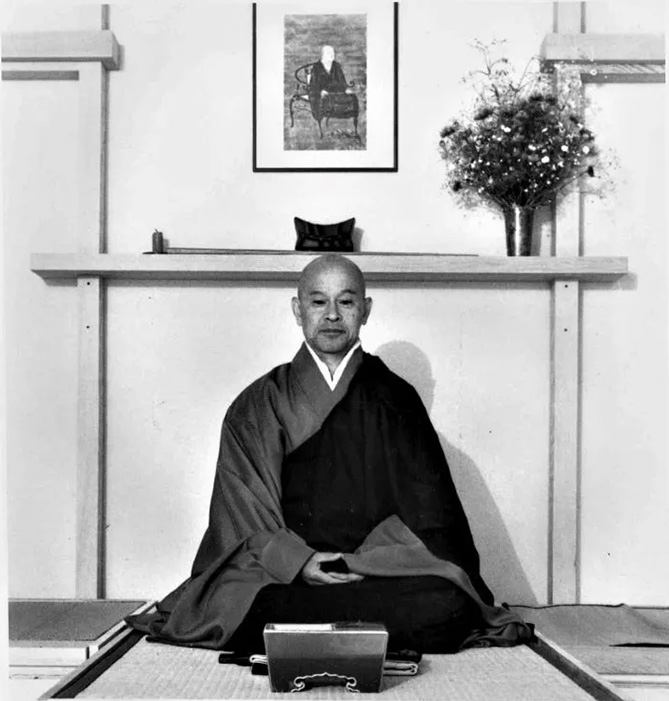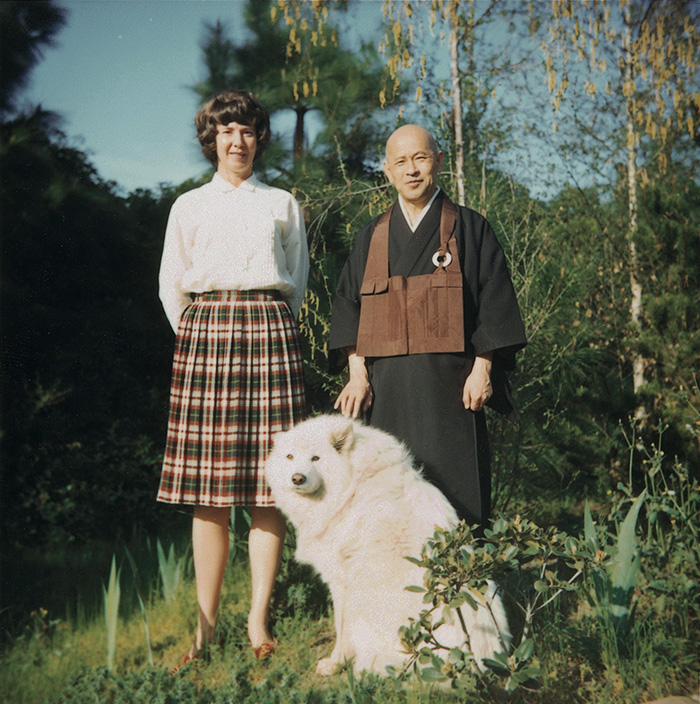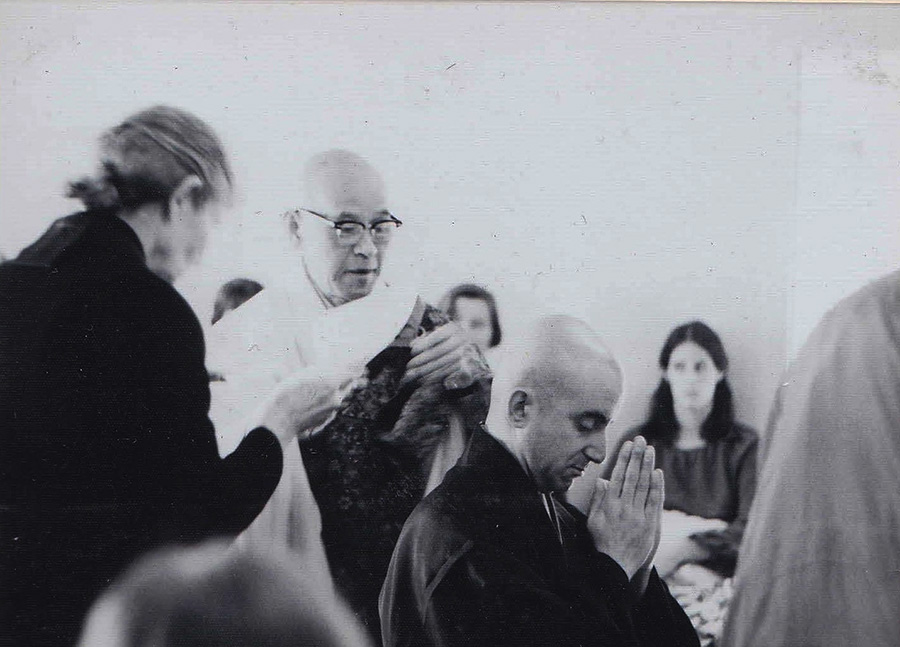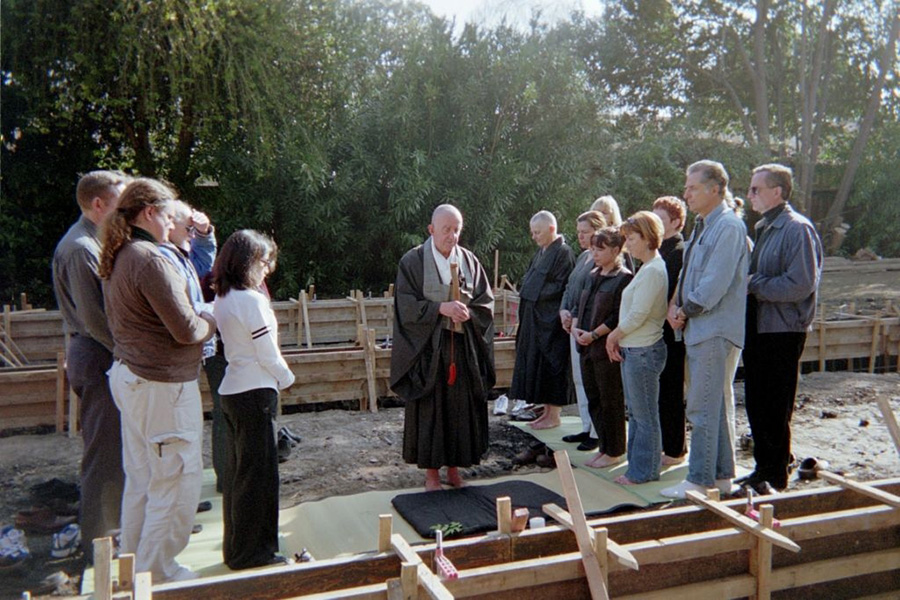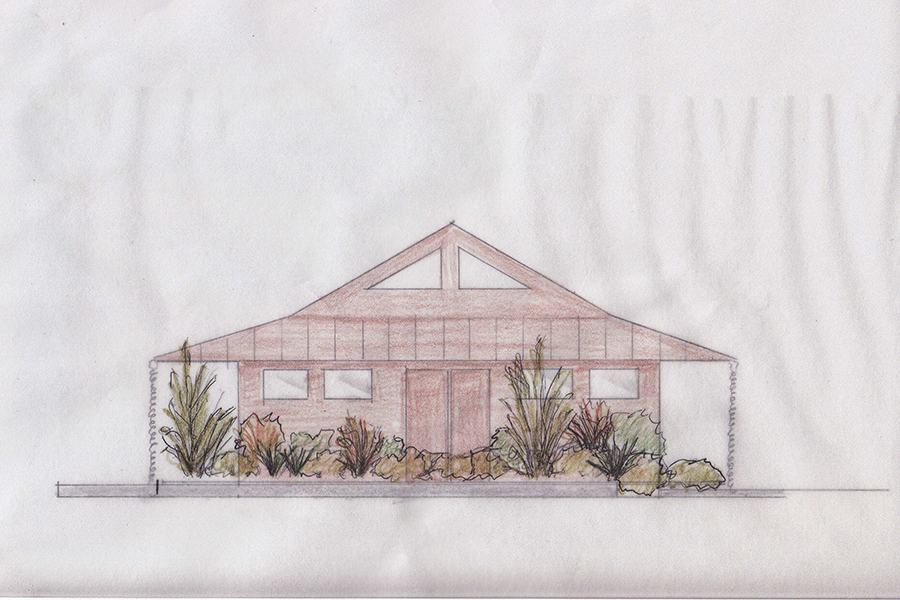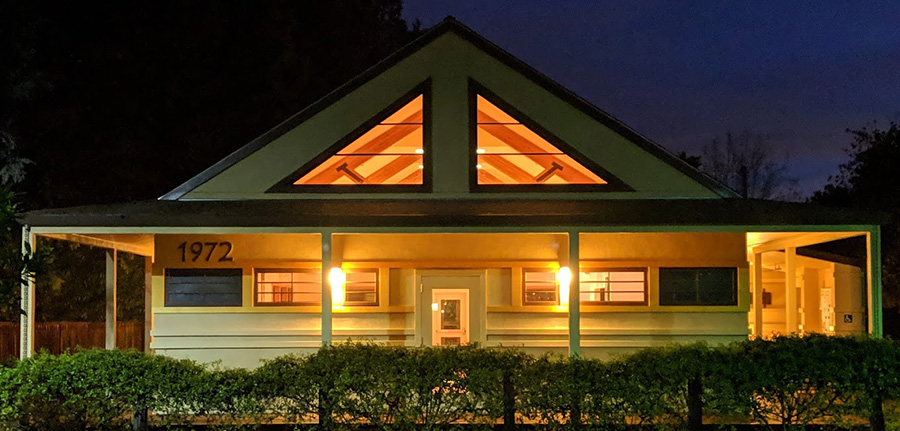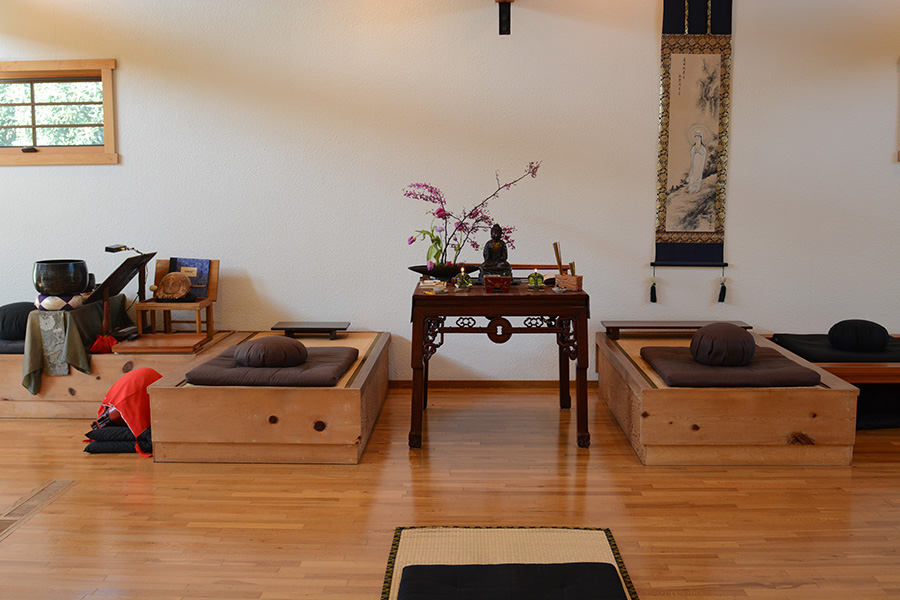A Brief History of Kannon Do and its Founders
In 1960, Les Kaye was well positioned to live the “American Dream.” He had a good education, a job with excellent career prospects at IBM, a lovely wife, and a home in Santa Clara Valley, known at the time as the “Valley of Hearts Delight.” Yet during the next decade, his life took an unusual turn.
During a weekend social visit to a friend in 1961, I came across Alan Watt’s The Way of Zen on my hostess’ bookshelf. A few random pages immediately caught my attention. I asked to borrow the book. Over that weekend, I was pulled as if by gravity to its portrayal of a dimension of living and an attitude of life that I had not recognized. When I closed the book, I knew that my technically-oriented, mainstream life was in some way incomplete. Watts’ narrative of Zen struck a chord of authenticity. In ways that I didn’t understand, it told me that Zen Buddhism promised freedom, in some inexplicable way expressing meaning beyond the ordinary.
In 1968, Les started attending Haiku Zendo, a small Zen group in Los Altos, led by Suzuki-roshi, literally meaning “Zen master,” who had come from Japan in 1959. The Wednesday evening program included a forty-minute period of meditation, known as zazen, and a lecture by Suzuki-roshi. Informal tea followed, giving students an opportunity to meet and chat with him. Saturday mornings included three periods of zazen and breakfast in the zendo, served monastic style.
Shunryu-Suzuki-roshi had arrived in San Francisco from Japan in 1959, fulfilling a long-held vision of bringing Zen to the United States. He had been invited by Sokoji, a Japanese-American temple on Bush Street, to be its head priest. In a short time, he was discovered by young Americans who joined him in zazen.
Over the next few years, more Americans found Suzuki-roshi and came to study and practice with him. In 1969, he and his new students moved from Sokoji, establishing the San Francisco Zen Center on Page Street. He was impressed by their fresh attitude. In one of his lectures he said “I feel Americans, especially young Americans, have a great opportunity to find out the true way of life for human beings. You are quite free from material things and you begin Zen practice with a very pure mind.”
In November, 1964, Suzuki-roshi started meeting with a small, informal meditation group in Palo Alto. Individuals took turns offering their homes, bringing their own cushions and rearranging living room furniture. The following year, one of the group, Marian Derby, offered to convert the garage in her Los Altos home to provide a central meeting place. Suzuki-roshi named the space Haiku Zendo, for the seventeen cushions that symbolized seventeen syllables in a Haiku poem. Haiku Zendo was a startup in a garage, in the days when tech. startups were beginning to appear in what was to become known as Silicon Valley.
On Wednesday evenings Suzuki-roshi was driven from San Francisco to lead meditation and offer a lecture. He often stayed overnight in Marian’s home for Thursday morning meditation and informal breakfast. Marian recorded his talks, published in 1970 as Zen Mind, Beginners Mind, providing the Western world the teachings and practice of Zen in clear and simple language. It was an instant best-seller. One of the most influential spiritual books of the 20th century, it is still in print after 50 years.
After two years of managing Haiku Zendo and Suzuki-roshi’s visits, Marian wanted to widen her Zen practice by attending Tassajara monastery. She wanted to avoid selling her house, thereby closing Haiku Zendo. In addition, two of her daughters were in high school, living at home. So in 1969 she asked Les if he would move with his family to take on administrative duties at Haiku Zendo, as well as keep an eye on her daughters. In October, 1969, they relocated to Los Altos at the time when Silicon Valley was starting to heat up, and life was becoming competitive and stressful.
To learn more about Marian Derby, go to this site:
http://www.cuke.com/people/wisberg-marian.htm
My family and I accepted the responsibility to assist Suzuki-roshi by living in the house and maintaining the schedule. I was convinced that Zen could help people find balance and focus and express their spiritual dimension. Less than a year after starting Zen practice, I began to experience my mind letting go of its incessant and distracting activities of intellect and desire. They were replaced by a sense of something greater, while my view of my life started to change. I became less ambitious and less oriented toward future success and more concerned with the way my life was going in the present. I wanted to live authentically and not be overwhelmed by the exciting attractions and comforts offered by modern society. I became more and more committed to Zen practice because I felt that it was the best thing humans could do for themselves. And I was determined to learn how to bring the ancient practice from a totally different time and culture into today’s world.
Les was ordained by Suzuki-roshi in January 1971, given the Dharma name Kakuzen Keido translated as “Awakening in Zen, Peaceful Way.” Later that year, the monk Kobun Chino came from Japan at Suzuki-roshi’s suggestion to become the teacher at Haiku Zendo.
In 1978, the growing Zen community relocated Haiku Zendo to a larger, more public space in Mountain View, re-naming it Kannon Do, “Place of Compassion.”
Suzuki-roshi’s legacy includes the San Francisco Zen Center and Tassajara – the first Zen monastery outside of Japan. Suzuki-roshi passed away in December of 1971 respected and beloved by all who came in contact with him, his teachings, and his way of being in the world.
For westerners in the modern world Buddhist teachings can be difficult to grasp and assimilate. The terminology presents unfamiliar concepts such as: dependent origination, emptiness, no self, tathagata, dukkha, right view, rebirth, and karma. It takes years of study to comprehend their meanings. In addition, the teachings are formal in style providing listeners and readers with information, as opposed to students learning from experience. Much of them are presented in lists such as: the three jewels, the four noble truths, the five aggregates, the five precepts, the six sense spheres, the noble eightfold path, the ten unwholesome courses of action, the twelve-fold chain of dependent co-arising, the eighteen sense elements, and the thirty two marks of the Buddha. Buddha’s teaching evolved from over two thousand years ago when Indian literature was primarily oral rather than written. In those days, lists were characteristic of learning, a necessary method to help the memory retain what the ear has heard.
Today’ spiritual seekers would rather not have to confront unfamiliar terminology and endless lists. Rather, they want to feel connected to what they read and hear, they want it presented in a way that is immediate and personal and that speaks to the heart, rather than the mind. Zen Mind, Beginners Mind does that by making Buddhist insights accessible through everyday language and familiar images. Along with intuition and experiences, images are indelible, beyond thinking. They increase our wisdom simply by happening.
A few of the images used by Suzuki-roshi in Zen Mind, Beginners Mind include the Waterfall, the Railroad Track, and Mind Weeds. The book ends with the following view of Reality: “One thing flows into another and cannot be grasped. Before the rain stops we hear a bird. Even under the heavy snow we see snowdrops and some new growth. In the east I saw rhubarb already. In the Japan in the spring we eat cucumbers.” With simple language, he offers a picture of ordinary activities taking pace in the midst of the universal truths of emptiness and constant change.
In 1985, Les received Dharma Transmission – authority to teach and have students – from Suzuki-roshi’s son and successor, Hoitsu Suzuki. When Kobun Chino moved to New Mexico to assist a new Zen group, Les was invited by the community to become Kannon Do’s first official abbot. Its growth during the 1990’s inspired a second relocation to larger facilities. The present Kannon Do was dedicated in 2006, providing all facilities of a traditional Zen temple.
Les authored three books – including Zen at Work – relating his experiences bringing the ancient practice of Zen to the culture and dynamics of the modern world, without diluting its fundamental essence. He also created the “Meditation at Work” program, bringing a secular form of Zen teaching and practice taught on-site at corporations and government agencies in Santa Clara Valley.
In 1990 I retired from professional life following 32 years in the corporate world, 22 years after starting Zen practice. Several Kannon Do members urged me to write a book about my “dual careers” as a technical professional and as a dedicated Zen practitioner.
I resisted the idea, feeling that writing a book about myself would be self-promoting and pushing the ego. I wanted to avoid those tendencies having learned that selflessness was the foundation of spirituality. My primary interest was in making the practice available to residents of what was becoming Silicon Valley. I had learned that books could not help increase understanding without the foundation of actual Zen practice.
Kannon Do members presented forceful rebuttals to my reluctance. One pointed out that in the mid-sixties there were only a few hundred Zen students but at the end of the twentieth century there were thousands. She argued that Zen was no longer a romantic notion, part of the counterculture, that the practice was not on the fringes anymore. I was reminded that today’s Zen students have careers and families, wrestling with a question they all share and that I had been trying to resolve: “How do I express spirituality in everyday life?”
I was told that my journey in Zen practice had been unique. “Has anybody else done what you’ve done? Are there any other Zen priests in IBM or the corporate world?” I was being politely nudged to share my experience with others as a way to encourage their practice.
The clincher came when I remembered how Suzuki-roshi was uninterested in writing a book and how that changed when some of his San Francisco Zen Center students told him that they planned to transcribe and edit the talks he had given at Haiku Zendo. They asked him to help and he agreed to advise. The result was Zen Mind, Beginners. Mind. So I gave up worrying about displaying ego and set out to create Zen at Work.
Les served as abbot of Kannon Do for 40 years, retiring in 2023 as abbot emeritus. No longer active in administrative matters of Kannon Do, he gives occasional Dharma talks and continues to meet with students in his home and virtually. At his “Stepping Down” retirement ceremony, Les gave the following closing Dharma talk:
Closing Dharma Talk
50 years ago I entered the world of the zendo
Immediately I felt at home
I found what I was seeking without knowing I was seeking
It was what Suzuki-roshi meant by our “Inmost desire,”
Finding the fundamental quality of being alive
Inherent in everyone
I discovered that the world of zendo was not a separate world
It was not a spiritual world different from an everyday world
There was no way to describe or explain the feeling
It was beyond the intellect
The world of zendo is the natural world
It is freedom from fear, it is joy for this life
The world of the zendo has windows without shades
It removes all obstacles to seeing what is real
The world of the zendo lets in the light
It is the real world
The world of sanity
Our Practice erases the imagined separation
Between the world of the zendo and the everyday world
It is the authentic life
It is Suzuki-roshi’s way
I had the good fortune and the opportunity to know Suzuki-roshi for two brief years
He showed me the meaning of the Bodhisattva way
He was a spiritual visionary for the modern world
It has been and honor and a privilege to have had a leadership role at Kannon Do
It has been 50 years exploring how to bring Zen practice into the light
Thank you for the opportunity
I made mistakes during my exploration
Please excuse my mistakes
Do not let them
Get in the way of your effort

